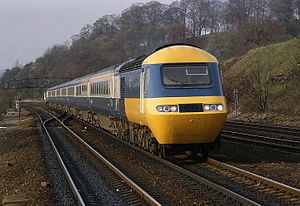
Back InterCity 125 Czech High Speed Train German High Speed Train French InterCity 125 Croatian InterCity 125 Hungarian InterCity 125 Italian インターシティー125 Japanese Intercity 125 Dutch InterCity 125 Portuguese InterCity 125 Russian
This article needs additional citations for verification. (October 2017) |
| InterCity 125 or High Speed Train (HST) | |||||||||
|---|---|---|---|---|---|---|---|---|---|
 An InterCity 125 in original British Rail livery | |||||||||
| |||||||||
| |||||||||
| |||||||||
| |||||||||
The InterCity 125 (originally Inter-City 125) or High Speed Train (HST) is a diesel-powered high-speed passenger train built by British Rail Engineering Limited between 1975 and 1982. A total of 95 sets were produced, each comprising two Class 43 power cars, one at each end, and a rake of seven or eight Mark 3 coaches. The name is derived from its top operational speed of 125 mph (201 km/h). At times, the sets have been classified as British Rail Classes 253, 254 and 255.
British Rail (BR) initially developed the HST as an interim measure in the early 1970s, as delays and cost concerns began to threaten their primary high-speed train project, the Advanced Passenger Train (APT). The HSTs are now widely considered to be among the most successful trains to have operated on the British railway network, both in terms of their initial impact and their longevity: their introduction into service between 1976 and 1982 resulted in significantly reduced journey times, and large increases in patronage on the routes on which they were operated. The trains proved to be a reliable workhorse, remaining in front-line service for decades. The first withdrawals began in 2017, 41 years after they were introduced. As of September 2023[update], InterCity 125s remain in service with ScotRail, Great Western Railway, and Network Rail.
The design became the basis for an Australian variant, the Express Passenger Train (XPT), which entered service in New South Wales in 1982.
- ^ "Mexico receives British HST fleet for Isthmus of Tehuantepec railway". International Railway Journal.